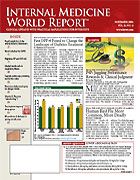Publication
Article
Outpatient Thyroidectomy Safe, Cost-Effective
Author(s):
Prophylactic Calcium Supplementation Required
TORONTO—Outpatient thyroid surgery is both safe and cost-effective for carefully selected patients as long as they receive prophylactic calcium supplementation, according to results of a new study presented at the 110th Annual Meeting of the American Academy of Otolaryngology—Head and Neck Surgery.
Traditionally, thyroidectomy has required hospitalizing a patient for days, or at least overnight, to monitor for complications affecting nearby structures, laryngeal nerve damage, hemorrhage, upper airway trauma, and life-threatening hypocalcemia. With the advent of minimally invasive approaches that allow shorter operative times and obviate the need for surgical drains, some physicians have pushed for more outpatient procedures, but others continue to insist that hospitalization is needed.
Although no clear consensus has been reached, the new study provides strong support for those on the outpatient side of the argument.
David J. Terris, MD, of the Medical College of Georgia, Augusta, discussed the results of this prospective, nonrandomized trial.
The study reviewed data from 91 consecutive patients (15 men and 76 women; mean age, 46.3 years) who underwent thyroidectomy between December 2004 and October 2005. A total of 52 patients were in the outpatient group and 39 in the inpatient group; 26 of the latter were only hospitalized overnight for a 23-hour observation period.
The techniques used included Kocher incision, minimally invasive thyroid surgery with access to the thyroid compartment, and endoscopic thyroidectomy.
All patients who underwent total or completion thyroidectomy were given a prophylactic calcium supplementation regimen consisting of 600 mg 3 times daily for the first week, followed by 600 mg twice daily for the second week, and 600 mg once daily for the third week. Flexible fiberoptic laryngoscopy was used to assess vocal cord mobility before and after surgery.
Those treated as outpatients were discharged home when they were ambulatory and able to tolerate eating. They were given oral analgesics for pain relief and told to return for follow-up evaluation in 1 to 2 weeks. Complications occurred in 2 outpatients and 1 inpatient.
As expected, costs were far lower for outpatients than inpatients—$7814 compared with $10,288, respectively.
Operative time was also shorter in the outpatient group (102 min vs 144 min). None of the patients in either group demonstrated signs or symptoms of calcium deficiency.
Despite the cost savings that were seen with the outpatient procedure, the investigators emphasized that the real benefits of ambulatory thyroidectomy were not necessarily financial, with advantages that included the convalescence at home as well as avoiding exposure to the infectious organisms often acquired in today’s hospitals.
The investigators emphasized that hospitalization should be considered for patients facing thyroid surgery who are medically infirm, undergoing concomitant procedures that would normally mandate admission, or who have a known blood disease. But in other patients, thyroid outpatient surgery should be seriously considered.






